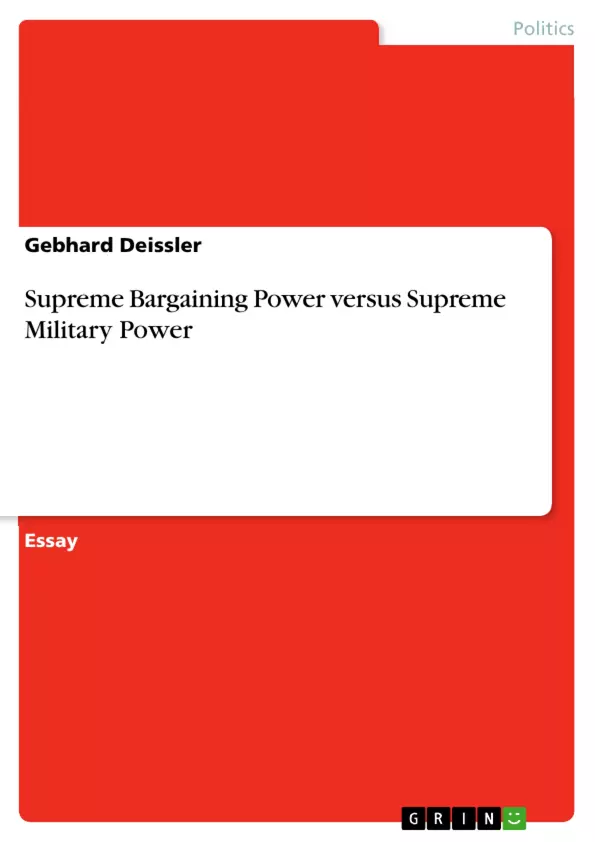Diverse strategic approaches are compared and evaluated with regard to their sustainability. The dawning of the third millennium could have been accompanied by an awakening to a new state of mind and consciousness that has shaken off millennia old methods of conflict resolution by means of violence. But, human and in particular national strategic thinking seems to be characterized by business as usual, as if one had learnt nothing over the past 2000 years and as if Jesus’s revolutionary intervention on human relational assumptions had never happened. And one pays the price for ignoring it out of self-complacency. How long can man ignore it in this multicultural millennium where conflict scenarios are likely to abound due to
multiple interrelated new factors at a planetary scale.
Inhaltsverzeichnis (Table of Contents)
- Supreme Bargaining Power versus Supreme Military Power
- The Third Millennium
- Man's Mind and the Logic of Violence
- Strategic Thinking in the West
- The Chinese Perspective on Strategy
- The Problem of Force
- The American Dilemma
Zielsetzung und Themenschwerpunkte (Objectives and Key Themes)
This text explores the changing nature of conflict in the third millennium and argues for a new strategic culture that prioritizes negotiation over military force. It challenges the traditional Western approach to strategy, which often relies on the assumption that violence can be controlled and used effectively.
- The shift from military power to negotiation as the dominant force in international relations
- The dangers of relying on military force in a globalized world
- The importance of understanding different cultural perspectives on strategy
- The role of economic and psychological factors in driving conflict
- The need for a new strategic culture that embraces peaceful conflict resolution
Zusammenfassung der Kapitel (Chapter Summaries)
- Supreme Bargaining Power versus Supreme Military Power: The text introduces the central theme of the shift from military dominance to negotiation as the primary means of resolving conflict in the third millennium. It argues that the traditional Western approach to strategy, which relies on the assumption that violence can be controlled and used effectively, is outdated and dangerous in a globalized world.
- The Third Millennium: This chapter explores the dawning of the third millennium and its potential to bring about a new era of peaceful conflict resolution. It argues that, despite the advent of new technologies and advancements in human understanding, the human psyche still remains largely conditioned by violence. This conditioning leads to a reliance on military force, even in situations where other solutions might be more effective.
- Man's Mind and the Logic of Violence: This chapter delves into the human tendency toward violence and its manifestation in strategic thinking. The text explores the concept of conditioning and argues that humanity has failed to transcend its reliance on violence, despite the availability of alternative methods of conflict resolution. It also discusses the danger of escalation and the uncontrollable nature of military force once it is unleashed.
- Strategic Thinking in the West: This chapter examines the evolution of strategic thinking in the West, highlighting the differences between European and American approaches. It analyzes the concept of gradual escalation, which is often used to justify military action, and argues that this approach is flawed because it underestimates the inherent unpredictability of violence.
- The Chinese Perspective on Strategy: This chapter explores the traditional Chinese approach to strategy, which emphasizes the need for holistic thinking and the avoidance of military force whenever possible. It highlights the importance of understanding different cultural perspectives on conflict resolution and how these perspectives can offer valuable insights for a more peaceful world.
- The Problem of Force: This chapter delves into the inherent dangers of using military force in a globalized world. It discusses the psychological scars left by violence and the potential for unintended consequences. It also explores the need for a more nuanced understanding of the relationship between force and international relations, recognizing that the use of force often leads to unintended negative outcomes.
- The American Dilemma: This chapter focuses on the American approach to strategy, arguing that it remains heavily influenced by a reliance on technology and a belief in the controllability of violence. It critiques the American tendency to see the world through the lens of power and control, and highlights the importance of considering alternative approaches to conflict resolution.
Schlüsselwörter (Keywords)
This text focuses on key concepts such as strategic culture, negotiation, military force, violence, escalation, globalized world, cultural perspectives, economic factors, psychological factors, and peaceful conflict resolution.
- Quote paper
- D.E.A./UNIV. PARIS I Gebhard Deissler (Author), 2011, Supreme Bargaining Power versus Supreme Military Power, Munich, GRIN Verlag, https://www.grin.com/document/169304



